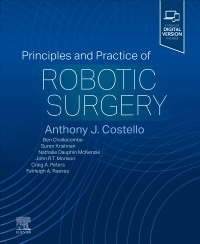
Principles and Practice of Robotic Surgery, 1st Edition
Hardcover

Now $273.41
-
- Covers every aspect of nearly all current adult and pediatric robotic surgeries in all surgical disciplines
- Includes key topics such as robotic anesthesia, operating room prep and positioning of the equipment, certification for robotic training, and the use of artificial intelligence and virtual reality in the present and potential future use of robotic surgery
- Discusses the evolution of robotic machines with a focus on new and emerging machines for surgery and education
- Provides specific docking instructions with tips and tricks for each robotic operation
- Offers comprehensive coverage in a magnificently illustrated, single-volume book, with contributions from an international Who’s Who of the world’s best robotic surgeons
- Offers numerous procedural videos, including Robotic Prostatectomy: The Patel Approach; Female Pelvic Organ Sparing (POP) and Male Nerve Sparing (NS) RARC; XiXi Operating Room and Surgical Cart setup for TORS, as well as various TORS procedures; Robotic Surgery in Pediatric Otolaryngology Head and Neck Surgery; and more
- An eBook version is included with purchase. The eBook allows you to access all of the text, figures and references, with the ability to search, customize your content, make notes and highlights, and have content read aloud
-
General principles
- Anesthesia for robotic surgery
- Physiology of pneumoperitoneum
- Complications
- Air embolism
- Arrest… etc
- Preoperative assessment and patient selection
- Patient positioning and prevention of injury
Bedside – including port placement and docking
- Draping robot
- (basic understanding in order to be able to deal with trouble shooting)
- Need all 4 arms to be draped even if not using
- Port placement
- Establishing pneumoperitoneum
- Hasson
- Veress
- Optical
- Insufflation pressure
- Complications and trouble shooting
- Eg. Adhesions, Obesity, Narrow pelvis, Prior surgery or radiotherapy, Existing stoma
- Docking the robot
- Modelled on Device teaching
- Targeting
- Ensuring adequate space between arms
- Burping
- Safety
- e.g. height limitation
- Locking instruments to avoid drift
- Emergency undocking
- Trouble shooting errors and faults
- Instruments
- Familiarity with commonly used laparoscopic instruments for the bedside assistant
- Inserting and exchanging instruments
- Diathermy settings
- How does it all work?
Console
- Basic rundown of buttons etc
- Controlling the camera
- Use of different lenses and changing view
- Understanding when/why to use different lens
- Swapping between instruments
- Fourth arm control
- Clutching
- Customising your setup
- Ergonomics
- Scaling ratio movement
- Adjusts movement speed to surgeon preference
- Default 3:1, 2:1, 1.5:1
- Available instruments
- Diathermy settings
OPERATING
Basic surgical skills on the console
- Haptics
- Definition
- Wrist movements
- Understanding how the system works and how optimise use
- Grasping objects
- Passing items between hands
- Cauterising
- Settings
- Knot tying
- Suturing
- Dissection and developing tissue planes
- Emergency management
- Vascular emergency
- ??other essential crisis management
- Trouble shooting
- Instrument out of view
- Use instrument out of view visual cues
- Only works if foot is on camera pedal
- Poor vision
- Switch dominant eye if smudge only on one side
- Can adjust zoom if tissue close and there is spatter/diathermy smoke issue
Surgical skills for the bedside assistant
- Fundamental laparoscopic skills
- Safe instrument handling
- Suctioning
- Clipping
- Stapling
- Cutting
- Specimen extraction
- Trouble shooting
- Loss of pneumoperitoneum
- Port loss (inadvertent removal)
- Port site closure
- Undocking robot
- Emergency and routine
Advanced aspects of operating
- Haemostatic agents
- Stapling
- Fluorescence imaging
- Tilepro
- E.g. USS
Simulation Training for Robotic Surgery
- Communication and human factors
- Team based training
- Operating room communication
- Virtual Reality Simulator Training
- Procedural Training
- 3D printed synthetic human organ hydrogel models (this model may soon replace animal and cadaver training in robotics)
- updates could be included with scannable QR codes and searchable web links. These links will provide access to the latest instructional content for the major robotic surgery systems
SPECIALTY SPECIFIC OUTLINE
For each specialty…
- Other fundamental skills not covered in basic course?
- Core procedures
- For each core procedure:
- Approach(es)
- Equipment required
- Patient positioning & operating room setup
- Port placement
- Docking
- Step by step procedure guide – operative steps/technique
- Particular specialised skills required for this procedure
- Urology
- General surgery
- General gynaecology and gynaecology Oncology
- Cardiac surgery
Nephrectomy partial nephrectomy pyeloplasty, intrarenal stone surgery, in surgery, nephroureterectomy, cystectomy, cystoprostatectomy, radical prostatectomy, retroperitoneal node to section.
Hernia surgery including incisional hernia and mesh hernia repair. Colorectal cancer surgery. Upper gastrointestinal surgery including obesity surgery antireflux surgery and gastric surgery. Pancreatic surgery. Appendicectomy and gallbladder surgery.
Hysterectomy oophorectomy endometriosis surgery
Radical hysterectomy radical ovarian surgery and retroperitoneal node to section
Sacrocolpopexy /incontinence surgery

 as described in our
as described in our 